Kerr-Lens Mode-Locked Femtosecond Yb:GdYSiO5 Laser Directly Pumped by a Laser Diode
Abstract
:1. Introduction
2. Experimental Layout
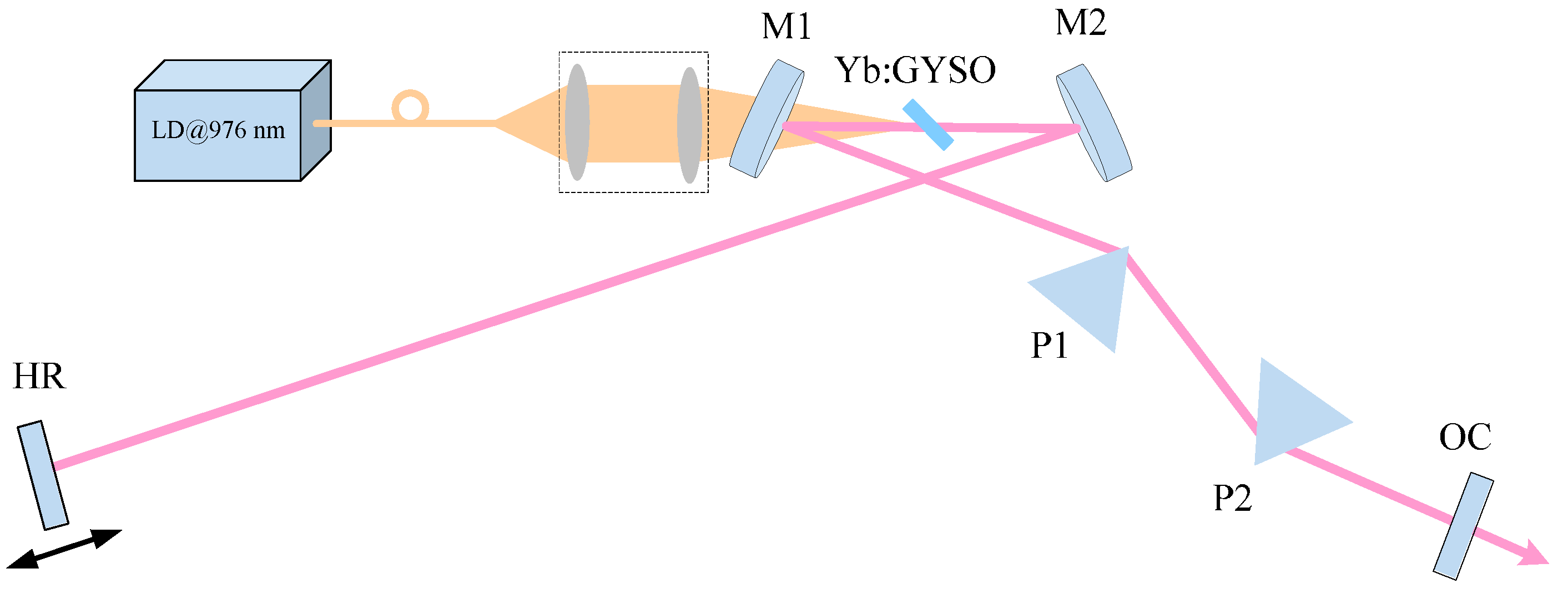
3. Experimental Results and Discussions
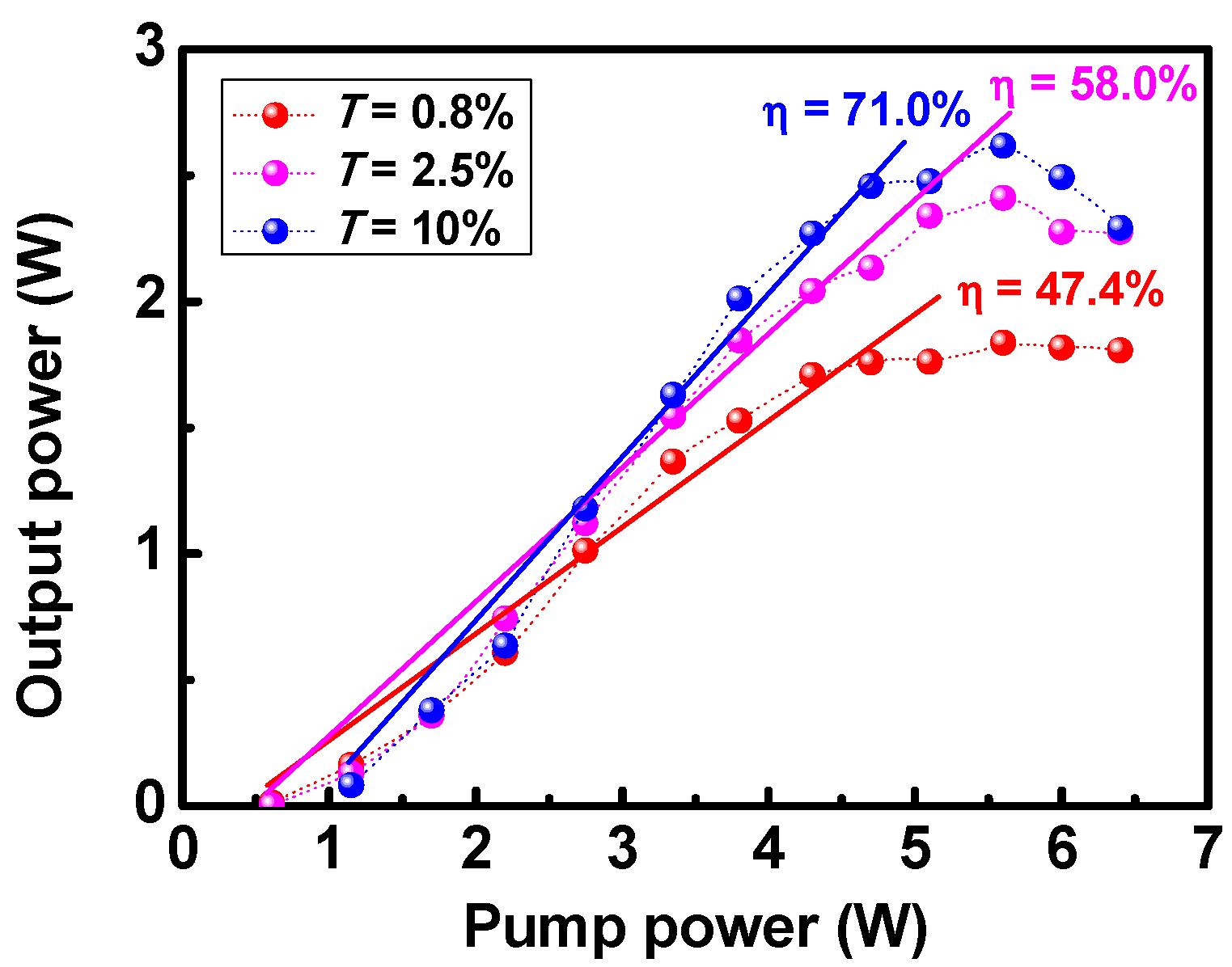
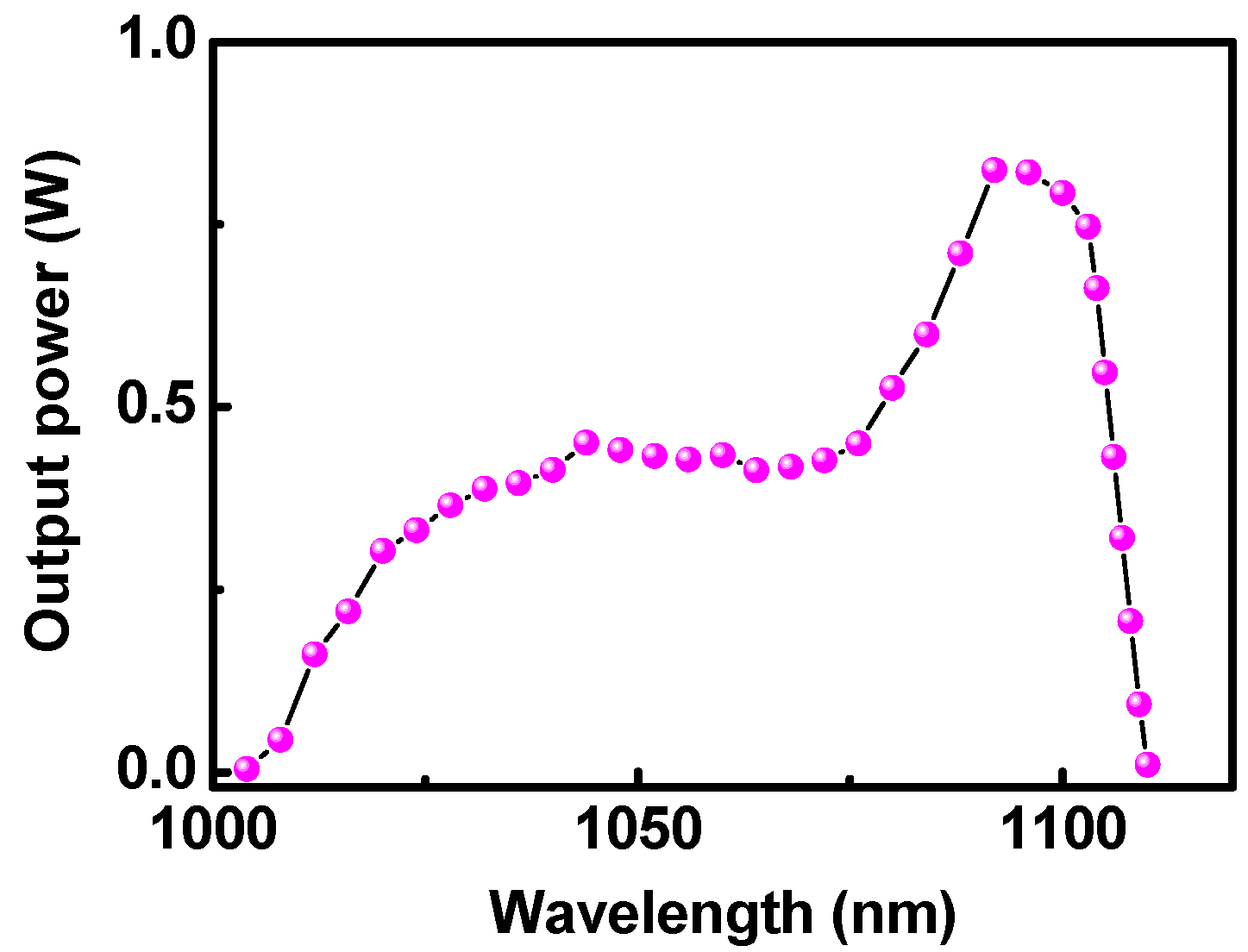
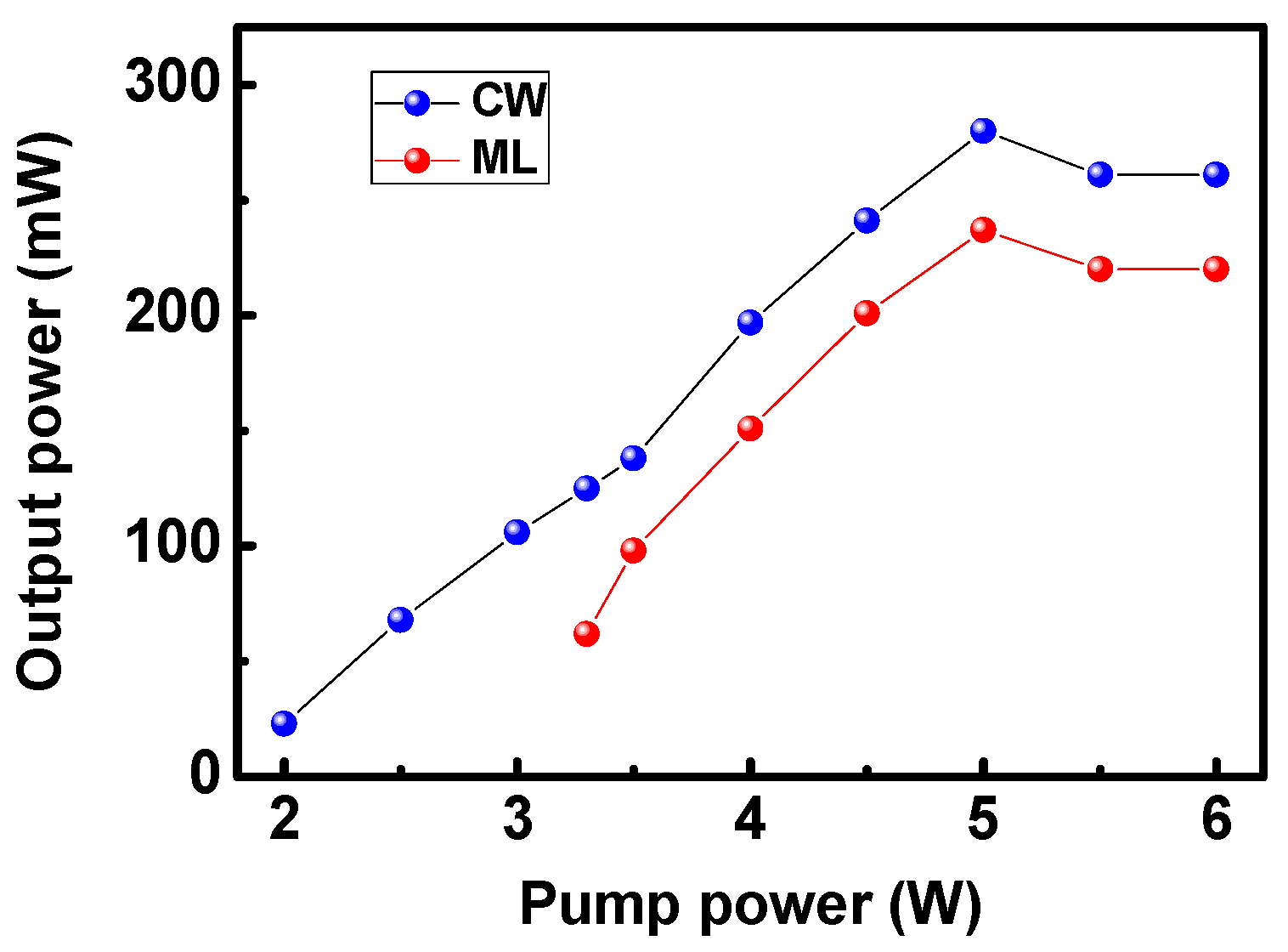

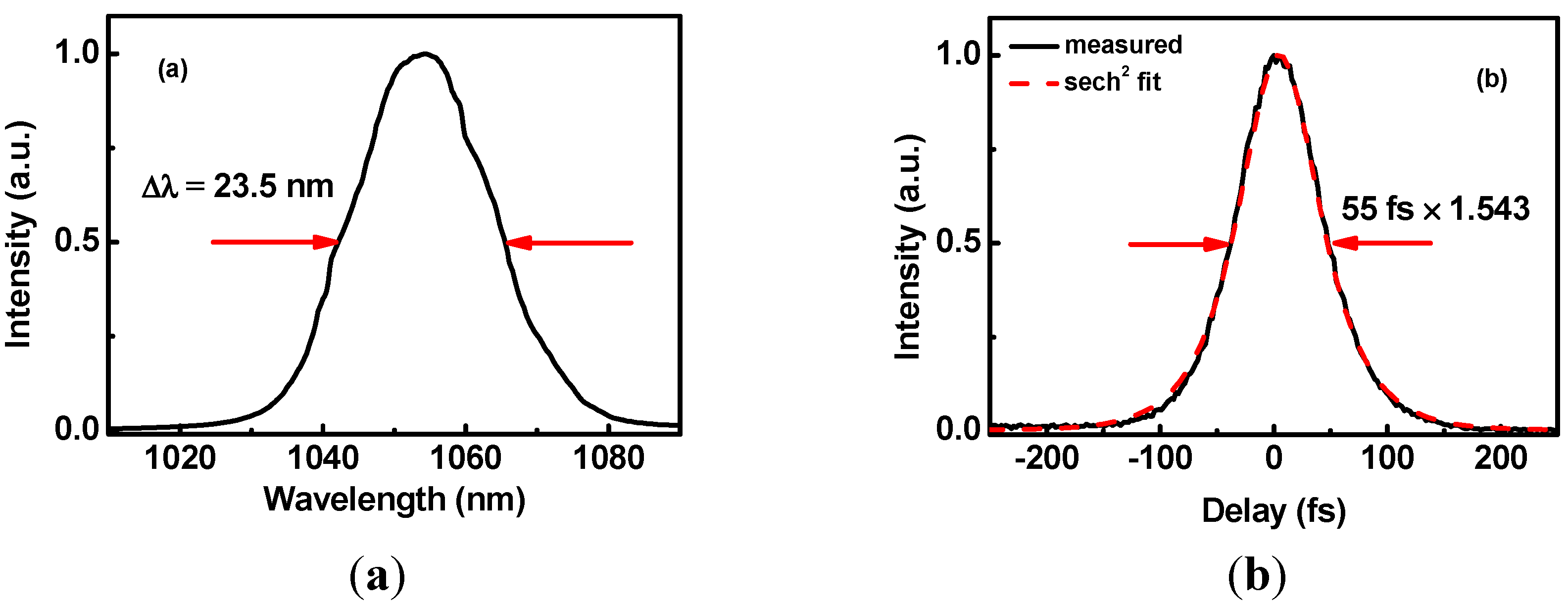
4. Conclusions
Acknowledgments
Author Contributions
Conflicts of Interest
References
- Krupke, W.F. Ytterbium solid-state lasers—The first decade. IEEE J. Select. Topics Quantum Electron. 2000, 6, 1287–1296. [Google Scholar] [CrossRef]
- Giesen, A.; Hugel, H.; Voss, A.; Wittig, K.; Brauch, U.; Opower, H. Scalable concept for diode-pumped high-power solid-state lasers. Appl. Phys. B 1994, 58, 365–372. [Google Scholar] [CrossRef]
- Machinet, G.; Sevillano, P.; Guichard, F.; Dubrasquet, R.; Camy, P.; Doualan, J.-L.; Moncorgé, R.; Georges, P.; Druon, F.; Descamps, D.; et al. High-brightness fiber laser-pumped 68 fs–2.3 W Kerr-lens mode-locked Yb:CaF2 oscillator. Opt. Lett. 2013, 38, 4008–4010. [Google Scholar] [CrossRef] [PubMed]
- Hoos, F.; Meyrath, T.P.; Li, S.; Braun, B.; Giessen, H. Femtosecond 5-W Yb:KGW slab laser oscillator pumped by a single broad-area diode and its application as supercontinuum source. Appl. Phys. B 2009, 96, 5–10. [Google Scholar] [CrossRef]
- Tokurakawa, M.; Takaichi, K.; Shirakawa, A.; Ueda, K.; Yagi, H.; yanagitani, T.; Kaminskii, A.A. Diode-pumped 188 fs mode-locked Yb3+:Y2O3 ceramic laser. Appl. Phys. Lett. 2007, 90. [Google Scholar] [CrossRef]
- Uemura, S.; Torizuka, K. Sub-40-fs pulses from a diode-pumped Kerr-lens mode-locked Yb-doped yttrium aluminum garnet laser. Jpn. J. Appl. Phys. 2011, 50. [Google Scholar] [CrossRef]
- Yoshida, A.; Schmidt, A.; Petrov, V.; Fiebig, C.; Erbert, G.; Liu, J.; Zhang, H.; Wang, J.; Griebner, U. Diode-pumped mode-locked Yb:YCOB laser generating 35 fs pulses. Opt. Lett. 2011, 36, 4425–4427. [Google Scholar] [CrossRef] [PubMed]
- Sévillano, P.; Georges, P.; Druon, F.; Descamps, D.; Cormier, E. 32-fs Kerr-lens mode-locked Yb:CaGdAlO4 oscillator optically pumped by a bright fiber laser. Opt. Lett. 2014, 39, 6001–6004. [Google Scholar] [CrossRef] [PubMed]
- Saraceno, C.J.; Emaury, F.; Heckl, O.H.; Baer, C.R.E.; Hoffmann, M.; Schriber, C.; Golling, M.; Südmeyer, T.; Keller, U. 275 W average output power from a femtosecond thin disk oscillator operated in a vacuum environment. Opt. Express 2012, 20, 23535–23541. [Google Scholar] [CrossRef] [PubMed]
- Baer, C.R.E.; Kränkel, C.; Saraceno, C.J.; Heckl, O.H.; Golling, M.; Peters, R.; Petermann, K.; Südmeyer, T.; Huber, G.; Keller, U. Femtosecond thin-disk laser with 141 W of average power. Opt. Lett. 2010, 35, 2302–2304. [Google Scholar] [CrossRef] [PubMed]
- Brons, J.; Pervak, V.; Fedulova, E.; Bauer, D.; Sutter, D.; Kalashnikov, V.; Apolonskiy, A.; Pronin, O.; Krausz, F. Energy scaling of Kerr-lens mode-locked thin-disk oscillators. Opt. Lett. 2014, 39, 6442–6445. [Google Scholar] [CrossRef] [PubMed]
- Neuhaus, J.; Bauer, D.; Zhang, J.; Killi, A.; Kleinbauer, J.; Kumkar, M.; Weiler, S.; Guina, M.; Sutter, D.H.; Dekorsy, T. Subpicosecond thin-disk laser oscillator with pulse energies of up to 25.9 microjoules by use of an active multipass geometry. Opt. Express 2008, 16, 20530–20539. [Google Scholar] [CrossRef] [PubMed]
- Bauer, D.; Zawischa, I.; Sutter, D.H.; Killi, A.; Dekorsy, T. Mode-locked Yb:YAG thin-disk oscillator with 41 µJ pulse energy at 145 W average infrared power and high power frequency conversion. Opt. Express 2012, 20, 9698–9704. [Google Scholar] [CrossRef] [PubMed]
- Saraceno, C.J.; Emaury, F.; Schriber, C.; Hoffmann, M.; Golling, M.; Südmeyer, T.; Keller, U. Ultrafast thin-disk laser with 80 μJ pulse energy and 242 W of average power. Opt. Lett. 2014, 39, 9–12. [Google Scholar] [CrossRef] [PubMed]
- Saraceno, C.J.; Heckl, O.H.; Baer, C.R.E.; Schriber, C.; Golling, M.; Beil, K.; Kränkel, C.; Südmeyer, T.; Huber, G.; Keller, U. Sub-100 femtosecond pulses from a SESAM mode-locked thin disk laser. Appl. Phys. B 2012, 106, 559–562. [Google Scholar] [CrossRef]
- Diebold, A.; Emaury, F.; Schriber, C.; Golling, M.; Saraceno, C.J.; Südmeyer, T.; Keller, U. SESAM mode-locked Yb:CaGdAlO4 thin disk laser with 62 fs pulse generation. Opt. Lett. 2013, 38, 3842–3845. [Google Scholar] [CrossRef] [PubMed]
- Jacquemet, M.; Jacquemet, C.; Janel, N.; Druon, F.; Balembois, F.; Georges, P.; Petit, J.; Viana, B.; Vivien, D.; Ferrand, B. Efficient laser action of Yb:LSO and Yb:YSO oxyorthosilicates crystals under high-power diode pumping. Appl. Phys. B 2005, 80, 171–176. [Google Scholar] [CrossRef]
- Zheng, L.; Xu, J.; Zhao, G.; Su, L.; Wu, F.; Liang, X. Bulk crystal growth and efficient diode-pumped laser performance of Yb3+:Sc2SiO5. Appl. Phys. B 2008, 91, 443–445. [Google Scholar] [CrossRef]
- Tian, W.; Wang, Z.; Zhu, J.; Wei, Z.; Zheng, L.; Xu, X.; Xu, J. Generation of 54 fs laser pulses from a diode pumped Kerr-lens mode-locked Yb:LSO laser. Chin. Phys. Lett. 2015, 32, 024206-1–024206-3. [Google Scholar] [CrossRef]
- Liu, C.; Wang, Y.; Liu, J.; Su, L.; Zheng, L.; Xu, J. Ultrafast Yb:Y2SiO5 laser investigation based on a carbon nanotube absorber. Appl. Opt. 2011, 50, 3229–3232. [Google Scholar] [CrossRef] [PubMed]
- Li, J.; Liang, X.; He, J.; Zheng, L.; Zhao, Z.; Xu, J. Diode pumped passively mode-locked Yb:SSO laser with 2. 3 ps duration. Opt. Express 2010, 18, 18354–18359. [Google Scholar] [CrossRef] [PubMed]
- Brickeen, B.K.; Geathers, E. Laser performance of Yb3+ doped oxyorthosilicates LYSO and GYSO. Opt. Express 2009, 17, 8461–8466. [Google Scholar] [CrossRef] [PubMed]
- Tian, W.; Wang, Z.; Wei, L.; Peng, Y.; Zhang, J.; Zhu, Z.; Zhu, J.; Han, H.; Jia, Y.; Zheng, L.; et al. Diode-pumped Kerr-lens mode-locked Yb:LYSO laser with 61 fs pulse duration. Opt. Express 2014, 22, 19040–19046. [Google Scholar] [CrossRef] [PubMed]
- Li, W.; Hao, Q.; Zhai, H.; Zeng, H.; Lu, W.; Zhao, G.; Yan, C.; Su, L.; Xu, J. Low-threshold and continuously tunable Yb:Gd2SiO5 laser. Appl. Phys. Lett. 2006, 89, 101125. [Google Scholar] [CrossRef]
© 2015 by the authors; licensee MDPI, Basel, Switzerland. This article is an open access article distributed under the terms and conditions of the Creative Commons Attribution license (http://creativecommons.org/licenses/by/4.0/).
Share and Cite
Zhu, J.; Gao, Z.; Tian, W.; Wang, J.; Wang, Z.; Wei, Z.; Zheng, L.; Su, L.; Xu, J. Kerr-Lens Mode-Locked Femtosecond Yb:GdYSiO5 Laser Directly Pumped by a Laser Diode. Appl. Sci. 2015, 5, 817-824. https://doi.org/10.3390/app5040817
Zhu J, Gao Z, Tian W, Wang J, Wang Z, Wei Z, Zheng L, Su L, Xu J. Kerr-Lens Mode-Locked Femtosecond Yb:GdYSiO5 Laser Directly Pumped by a Laser Diode. Applied Sciences. 2015; 5(4):817-824. https://doi.org/10.3390/app5040817
Chicago/Turabian StyleZhu, Jiangfeng, Ziye Gao, Wenlong Tian, Junli Wang, Zhaohua Wang, Zhiyi Wei, Lihe Zheng, Liangbi Su, and Jun Xu. 2015. "Kerr-Lens Mode-Locked Femtosecond Yb:GdYSiO5 Laser Directly Pumped by a Laser Diode" Applied Sciences 5, no. 4: 817-824. https://doi.org/10.3390/app5040817




